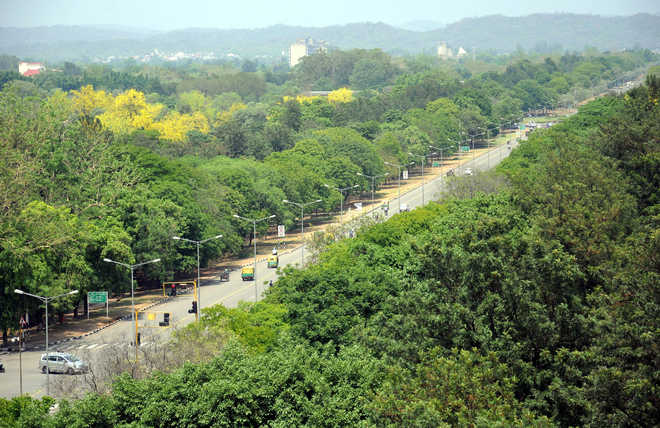
Trees are getting loped off by the itinerant workforce for fuel on the one hand, and on the other by the mania to widen internal roads. Manoj Mahajan
Lt Gen Baljit Singh (Retd)
Driving home on March 23 this year after a brief first meeting with an erudite gentleman, I was left grappling with the proposition as to how much the inevitable march of urbanisation may impact the open and green spaces in and around independent India’s first planned city.
It was natural that my memory would seek out the imprint of my first arrival in Chandigarh in December, 1956, when it was truly a vast, green landscape with nary a single habitation cluster larger than a cricket stadium.
My parents resided in one of a dozen or so single-storey government bungalows situated in an ancient grove of mango and neem trees close to Nagla, a thriving village dwelling but sans any hostile intent towards the new settlers and the emerging city.
The covered floor space per se of the bungalows was strictly of utility category but lawns were spacious and hedges thick and high. And the dominant vision of my first dawn in Chandigarh is of the incredibly pleasant crescendo of peacock calls, emerging from the mango and neem grove and then as is their wont, the loud, combined cackle of at least a dozen birds in descent from night roosts.
And goodly flocks of parakeets (rose-ringed, plum-headed and Alexandrine) streaming past in species-specific flocks overhead, muttering in gossip what an ornithologist had once narrated: “Catherine, can you guess who Judy spent the night-roost with?...Shocking, isn’t it!”
But the show-stealers were invariably the omnipresent grey partridges calling to neighbours first from inside the hedges and again on descending to lawns before picking termites for breakfast. But hold your breath for the delights which were on offer on moonlit nights, looking out through chinks in drawn curtains. Invariably, there were a few common Indian hare, nibbling on tender grass shoots. Today, 60 years later, urbanisation has rid Chandigarh of the sights and sounds of peacocks, parakeets (except for the rose-ringed species), partridges (grey and black), hare and much else from its ecological basket and ushered what invariably follows in the wake of urbanisation — the noise of revving automobile engines emitting pungent exhaust fumes, skyline beginning to crowd with high-rise constructions (admittedly some with sleek looks), good eateries, dependable medicare, a few jiving discotheques and many more lifestyle conveniences and necessities.
Yet, I fear that the emerging reality of Chandigarh may be similar to the anguished vision stated by the Red Indian Chief, Seattle, in a letter written in 1854 to President Franklin Pierce concerning the ecological degradation of the land caused by unbridled urbanisation:
“There is no quiet place in the white man’s cities. No place to hear the unfurling of leaves in spring, or the rustle of an insect’s wings. But perhaps it is because I am a savage and do not understand. The clatter only seems to insult the ears. And what is there to life if a man cannot hear the lonely cry of the whirlpool or the arguments of the frogs around a pond at night... the soft sound of the wind darting over the face of a pond, and the smell of the wind itself, cleansed by rain or scented with the pine cone”.
Now, when was the last sighting of a peacock within the city limits? Going by my experience, the requiem for peacock in our metropolises was perhaps played out by 2000. Take, for instance, a photograph of a cultural performance two months back in which the centrepiece of the dancer’s costume is a fan attached at the waist, made from a mass of tail feathers of the male peacock. That fan ornamentation worn by each dancer would, by a conservative estimate, account for upwards of six peacocks. The tragic conclusion is that those feathers came from peacocks killed on intent. And the agents of crime are the underprivileged workforce.
This is not to suggest that we curb some prevalent lifestyles and utilities; rather, we must look for novel alternatives — for instance, replace the biological tail feathers by synthetic, lookalike products.
In the instant case, living alongside the peacock, the grey partridge, the parakeets, the common Indian hare and others, inside of Chandigarh city limits, have become memories from the past. But one other adjunct which may get severely depleted next, is the rich wealth of trees lining the road avenues. Trees are getting loped off by the itinerant workforce for fuel on the one hand, and on the other by the mania to widen internal roads.
In the process, roads are extended to hug the tree bole, the bitumen mass compresses the root stalk and the tree is unable to extract nutrients from the top soil in a natural way and is also starved of percolated rain water.
Is anyone listening?



























